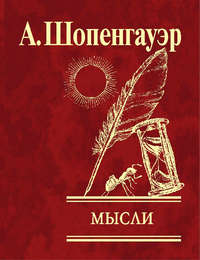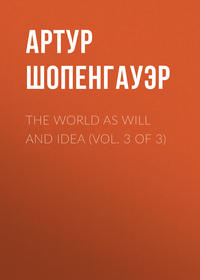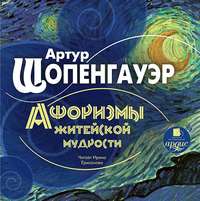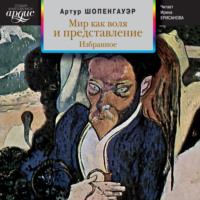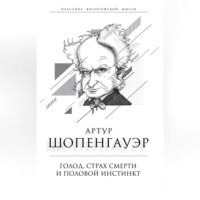 полная версия
полная версияThe World as Will and Idea (Vol. 1 of 3)
It was mentioned above that in order rightly to portray man, it is necessary to separate the character of the species from that of the individual, so that to a certain extent every man expresses an Idea peculiar to himself, as was said in the last book. Therefore the arts whose aim is the representation of the Idea of man, have as their problem, not only beauty, the character of the species, but also the character of the individual, which is called, par excellence, character. But this is only the case in so far as this character is to be regarded, not as something accidental and quite peculiar to the man as a single individual, but as a side of the Idea of humanity which is specially apparent in this individual, and the representation of which is therefore of assistance in revealing this Idea. Thus the character, although as such it is individual, must yet be Ideal, that is, its significance in relation to the Idea of humanity generally (the objectifying of which it assists in its own way) must be comprehended and expressed with special prominence. Apart from this the representation is a portrait, a copy of the individual as such, with all his accidental qualities. And even the portrait ought to be, as Winckelmann says, the ideal of the individual.
That character which is to be ideally comprehended, as the prominence of a special side of the Idea of humanity, expresses itself visibly, partly through permanent physiognomy and bodily form, partly through passing emotion and passion, the reciprocal modification of knowing and willing by each other, which is all exhibited in the mien and movements. Since the individual always belongs to humanity, and, on the other hand, humanity always reveals itself in the individual with what is indeed peculiar ideal significance, beauty must not be destroyed by character nor character by beauty. For if the character of the species is annulled by that of the individual, the result is caricature; and if the character of the individual is annulled by that of the species, the result is an absence of meaning. Therefore the representation which aims at beauty, as sculpture principally does, will yet always modify this (the character of the species), in some respect, by the individual character, and will always express the Idea of man in a definite individual manner, giving prominence to a special side of it. For the human individual as such has to a certain extent the dignity of a special Idea, and it is essential to the Idea of man that it should express itself in individuals of special significance. Therefore we find in the works of the ancients, that the beauty distinctly comprehended by them, is not expressed in one form, but in many forms of different character. It is always apprehended, as it were, from a different side, and expressed in one way in Apollo, in another way in Bacchus, in another in Hercules, in another in Antinous; indeed the characteristic may limit the beautiful, and finally extend even to hideousness, in the drunken Silenus, in the Faun, &c. If the characteristic goes so far as actually to annul the character of the species, if it extends to the unnatural, it becomes caricature. But we can far less afford to allow grace to be interfered with by what is characteristic than even beauty, for graceful position and movement are demanded for the expression of the character also; but yet it must be achieved in the way which is most fitting, appropriate, and easy for the person. This will be observed, not only by the sculptor and the painter, but also by every good actor; otherwise caricature will appear here also as grimace or distortion.
In sculpture, beauty and grace are the principal concern. The special character of the mind, appearing in emotion, passion, alternations of knowing and willing, which can only be represented by the expression of the countenance and the gestures, is the peculiar sphere of painting. For although eyes and colour, which lie outside the province of sculpture, contribute much to beauty, they are yet far more essential to character. Further, beauty unfolds itself more completely when it is contemplated from various points of view; but the expression, the character, can only be completely comprehended from one point of view.
Because beauty is obviously the chief aim of sculpture, Lessing tried to explain the fact that the Laocoon does not cry out, by saying that crying out is incompatible with beauty. The Laocoon formed for Lessing the theme, or at least the text of a work of his own, and both before and after him a great deal has been written on the subject. I may therefore be allowed to express my views about it in passing, although so special a discussion does not properly belong to the scheme of this work, which is throughout concerned with what is general.
§ 46. That Laocoon, in the celebrated group, does not cry out is obvious, and the universal and ever-renewed surprise at this must be occasioned by the fact that any of us would cry out if we were in his place. And nature demands that it should be so; for in the case of the acutest physical pain, and the sudden seizure by the greatest bodily fear, all reflection, that might have inculcated silent endurance, is entirely expelled from consciousness, and nature relieves itself by crying out, thus expressing both the pain and the fear, summoning the deliverer and terrifying the assailer. Thus Winckelmann missed the expression of crying out; but as he wished to justify the artist he turned Laocoon into a Stoic, who considered it beneath his dignity to cry out secundum naturam, but added to his pain the useless constraint of suppressing all utterance of it. Winckelmann therefore sees in him “the tried spirit of a great man, who writhes in agony, and yet seeks to suppress the utterance of his feeling, and to lock it up in himself. He does not break forth into loud cries, as in Virgil, but only anxious sighs escape him,” &c. (Works, vol. vii. p. 98, and at greater length in vol. vi. p. 104). Now Lessing criticised this opinion of Winckelmann's in his Laocoon, and improved it in the way mentioned above. In place of the psychological he gave the purely æsthetic reason that beauty, the principle of ancient art, does not admit of the expression of crying out. Another argument which he added to this, that a merely passing state incapable of duration ought not to be represented in motionless works of art, has a hundred examples of most excellent figures against it, which are fixed in merely transitory movements, dancing, wrestling, catching, &c. Indeed Goethe, in the essay on the Laocoon, which opens the Propylaen (p. 8), holds that the choice of such a merely fleeting movement is absolutely necessary. In our own day Hirt (Horen, 1797, tenth St.) finally decided the point, deducing everything from the highest truth of expression, that Laocoon does not cry out, because he can no longer do so, as he is at the point of death from choking. Lastly, Fernow (“Römische Studien,” vol. i. p. 246) expounded and weighed all these opinions; he added, however, no new one of his own, but combined these three eclectically.
I cannot but wonder that such thoughtful and acute men should laboriously bring far-fetched and insufficient reasons, should resort to psychological and physiological arguments, to explain a matter the reason of which lies so near at hand, and is obvious at once to the unprejudiced; and especially I wonder that Lessing, who came so near the true explanation, should yet have entirely missed the real point.
Before all psychological and physiological inquiries as to whether Laocoon would cry out in his position or not (and I certainly affirm that he would), it must be decided as regards the group in question, that crying out ought not to be expressed in it, for the simple reason that its expression lies quite outside the province of sculpture. A shrieking Laocoon could not be produced in marble, but only a figure with the mouth open vainly endeavouring to shriek; a Laocoon whose voice has stuck in his throat, vox faucibus haesit. The essence of shrieking, and consequently its effect upon the onlooker, lies entirely in sound; not in the distortion of the mouth. This phenomenon, which necessarily accompanies shrieking, derives motive and justification only from the sound produced by means of it; then it is permissible and indeed necessary, as characteristic of the action, even though it interferes with beauty. But in plastic art, to which the representation of shrieking is quite foreign and impossible, it would be actual folly to represent the medium of violent shrieking, the distorted mouth, which would disturb all the features and the remainder of the expression; for thus at the sacrifice of many other things the means would be represented, while its end, the shrieking itself, and its effect upon our feelings, would be left out. Nay more, there would be produced the spectacle of a continuous effort without effect, which is always ridiculous, and may really be compared to what happened when some one for a joke stopped the horn of a night watchman with wax while he was asleep, and then awoke him with the cry of fire, and amused himself by watching his vain endeavours to blow the horn. When, on the other hand, the expression of shrieking lies in the province of poetic or histrionic art, it is quite admissible, because it helps to express the truth, i. e., the complete expression of the Idea. Thus it is with poetry, which claims the assistance of the imagination of the reader, in order to enable it to represent things perceptibly. Therefore Virgil makes Laocoon cry out like the bellowing of an ox that has broken loose after being struck by the axe; and Homer (Il. xx. 48-53) makes Mars and Minerva shriek horribly, without derogating from their divine dignity or beauty. The same with acting; Laocoon on the stage would certainly have to shriek. Sophocles makes Philoctetus cry out, and, on the ancient stage at any rate, he must actually have done so. As a case in point, I remember having seen in London the great actor Kemble play in a piece called Pizarro, translated from the German. He took the part of the American, a half-savage, but of very noble character. When he was wounded he cried out loudly and wildly, which had a great and admirable effect, for it was exceedingly characteristic and therefore assisted the truth of the representation very much. On the other hand, a painted or sculptured model of a man shrieking, would be much more absurd than the painted music which is censured in Goethe's Propylaen. For shrieking does far more injury to the expression and beauty of the whole than music, which at the most only occupies the hands and arms, and is to be looked upon as an occupation characteristic of the person; indeed thus far it may quite rightly be painted, as long as it demands no violent movement of the body, or distortion of the mouth: for example, St. Cecilia at the organ, Raphael's violin-player in the Sciarra Gallery at Rome, and others. Since then, on account of the limits of the art, the pain of Laocoon must not be expressed by shrieking, the artist was obliged to employ every other expression of pain; this he has done in the most perfect manner, as is ably described by Winckelmann (Works, vol. vi. p. 104), whose admirable account thus retains its full value and truth, as soon as we abstract from the stoical view which underlies it.56
§ 47. Because beauty accompanied with grace is the principal object of sculpture, it loves nakedness, and allows clothing only so far as it does not conceal the form. It makes use of drapery, not as a covering, but as a means of exhibiting the form, a method of exposition that gives much exercise to the understanding, for it can only arrive at a perception of the cause, the form of the body, through the only directly given effect, the drapery. Thus to a certain extent drapery is in sculpture what fore-shortening is in painting. Both are suggestions, yet not symbolical, but such that, if they are successful, they force the understanding directly to perceive what is suggested, just as if it were actually given.
I may be allowed, in passing, to insert here a comparison that is very pertinent to the arts we are discussing. It is this: as the beautiful bodily form is seen to the greatest advantage when clothed in the lightest way, or indeed without any clothing at all, and therefore a very handsome man, if he had also taste and the courage to follow it, would go about almost naked, clothed only after the manner of the ancients; so every one who possesses a beautiful and rich mind will always express himself in the most natural, direct, and simple way, concerned, if it be possible, to communicate his thoughts to others, and thus relieve the loneliness that he must feel in such a world as this. And conversely, poverty of mind, confusion, and perversity of thought, will clothe itself in the most far-fetched expressions and the obscurest forms of speech, in order to wrap up in difficult and pompous phraseology small, trifling, insipid, or commonplace thoughts; like a man who has lost the majesty of beauty, and trying to make up for the deficiency by means of clothing, seeks to hide the insignificance or ugliness of his person under barbaric finery, tinsel, feathers, ruffles, cuffs, and mantles. Many an author, if compelled to translate his pompous and obscure book into its little clear content, would be as utterly spoilt as this man if he had to go naked.
§ 48. Historical painting has for its principal object, besides beauty and grace, character. By character we mean generally, the representation of will at the highest grade of its objectification, when the individual, as giving prominence to a particular side of the Idea of humanity, has special significance, and shows this not merely by his form, but makes it visible in his bearing and occupation, by action of every kind, and the modifications of knowing and willing that occasion and accompany it. The Idea of man must be exhibited in these circumstances, and therefore the unfolding of its many-sidedness must be brought before our eyes by means of representative individuals, and these individuals can only be made visible in their significance through various scenes, events, and actions. This is the endless problem of the historical painter, and he solves it by placing before us scenes of life of every kind, of greater or less significance. No individual and no action can be without significance; in all and through all the Idea of man unfolds itself more and more. Therefore no event of human life is excluded from the sphere of painting. It is thus a great injustice to the excellent painters of the Dutch school, to prize merely their technical skill, and to look down upon them in other respects, because, for the most part, they represent objects of common life, whereas it is assumed that only the events of the history of the world, or the incidents of biblical story, have significance. We ought first to bethink ourselves that the inward significance of an action is quite different from its outward significance, and that these are often separated from each other. The outward significance is the importance of an action in relation to its result for and in the actual world; thus according to the principle of sufficient reason. The inward significance is the depth of the insight into the Idea of man which it reveals, in that it brings to light sides of that Idea which rarely appear, by making individuals who assert themselves distinctly and decidedly, disclose their peculiar characteristics by means of appropriately arranged circumstances. Only the inward significance concerns art; the outward belongs to history. They are both completely independent of each other; they may appear together, but may each appear alone. An action which is of the highest significance for history may in inward significance be a very ordinary and common one; and conversely, a scene of ordinary daily life may be of great inward significance, if human individuals, and the inmost recesses of human action and will, appear in it in a clear and distinct light. Further, the outward and the inward significance of a scene may be equal and yet very different. Thus, for example, it is all the same, as far as inward significance is concerned, whether ministers discuss the fate of countries and nations over a map, or boors wrangle in a beer-house over cards and dice, just as it is all the same whether we play chess with golden or wooden pieces. But apart from this, the scenes and events that make up the life of so many millions of men, their actions, their sorrows, their joys, are on that account important enough to be the object of art, and by their rich variety they must afford material enough for unfolding the many-sided Idea of man. Indeed the very transitoriness of the moment which art has fixed in such a picture (now called genre-painting) excites a slight and peculiar sensation; for to fix the fleeting, ever-changing world in the enduring picture of a single event, which yet represents the whole, is an achievement of the art of painting by which it seems to bring time itself to a standstill, for it raises the individual to the Idea of its species. Finally, the historical and outwardly significant subjects of painting have often the disadvantage that just what is significant in them cannot be presented to perception, but must be arrived at by thought. In this respect the nominal significance of the picture must be distinguished from its real significance. The former is the outward significance, which, however, can only be reached as a conception; the latter is that side of the Idea of man which is made visible to the onlooker in the picture. For example, Moses found by the Egyptian princess is the nominal significance of a painting; it represents a moment of the greatest importance in history; the real significance, on the other hand, that which is really given to the onlooker, is a foundling child rescued from its floating cradle by a great lady, an incident which may have happened more than once. The costume alone can here indicate the particular historical case to the learned; but the costume is only of importance to the nominal significance, and is a matter of indifference to the real significance; for the latter knows only the human being as such, not the arbitrary forms. Subjects taken from history have no advantage over those which are taken from mere possibility, and which are therefore to be called, not individual, but merely general. For what is peculiarly significant in the former is not the individual, not the particular event as such, but the universal in it, the side of the Idea of humanity which expresses itself through it. But, on the other hand, definite historical subjects are not on this account to be rejected, only the really artistic view of such subjects, both in the painter and in the beholder, is never directed to the individual particulars in them, which properly constitute the historical, but to the universal which expresses itself in them, to the Idea. And only those historical subjects are to be chosen the chief point of which can actually be represented, and not merely arrived at by thought, otherwise the nominal significance is too remote from the real; what is merely thought in connection with the picture becomes of most importance, and interferes with what is perceived. If even on the stage it is not right that the chief incident of the plot should take place behind the scenes (as in French tragedies), it is clearly a far greater fault in a picture. Historical subjects are distinctly disadvantageous only when they confine the painter to a field which has not been chosen for artistic but for other reasons, and especially when this field is poor in picturesque and significant objects – if, for example, it is the history of a small, isolated, capricious, hierarchical (i. e., ruled by error), obscure people, like the Jews, despised by the great contemporary nations of the East and the West. Since the wandering of the tribes lies between us and all ancient nations, as the change of the bed of the ocean lies between the earth's surface as it is to-day and as it was when those organisations existed which we only know from fossil remains, it is to be regarded generally as a great misfortune that the people whose culture was to be the principal basis of our own were not the Indians or the Greeks, or even the Romans, but these very Jews. But it was especially a great misfortune for the Italian painters of genius in the fifteenth and sixteenth centuries that, in the narrow sphere to which they were arbitrarily driven for the choice of subjects, they were obliged to have recourse to miserable beings of every kind. For the New Testament, as regards its historical part, is almost more unsuitable for painting than the Old, and the subsequent history of martyrs and doctors of the church is a very unfortunate subject. Yet of the pictures, whose subject is the history or mythology of Judaism and Christianity, we must carefully distinguish those in which the peculiar, i. e., the ethical spirit of Christianity is revealed for perception, by the representation of men who are full of this spirit. These representations are in fact the highest and most admirable achievements of the art of painting; and only the greatest masters of this art succeeded in this, particularly Raphael and Correggio, and especially in their earlier pictures. Pictures of this kind are not properly to be classed as historical: for, as a rule, they represent no event, no action; but are merely groups of saints, with the Saviour himself, often still a child, with His mother, angels, &c. In their countenances, and especially in the eyes, we see the expression, the reflection, of the completest knowledge, that which is not directed to particular things, but has fully grasped the Ideas, and thus the whole nature of the world and life. And this knowledge in them, reacting upon the will, does not, like other knowledge, convey motives to it, but on the contrary has become a quieter of all will, from which proceeded the complete resignation, which is the innermost spirit of Christianity, as of the Indian philosophy; the surrender of all volition, conversion, the suppression of will, and with it of the whole inner being of this world, that is to say, salvation. Thus these masters of art, worthy of eternal praise, expressed perceptibly in their works the highest wisdom. And this is the summit of all art. It has followed the will in its adequate objectivity, the Ideas, through all its grades, in which it is affected and its nature unfolded in so many ways, first by causes, then by stimuli, and finally by motives. And now art ends with the representation of the free self-suppression of will, by means of the great peace which it gains from the perfect knowledge of its own nature.57
§ 49. The truth which lies at the foundation of all that we have hitherto said about art, is that the object of art, the representation of which is the aim of the artist, and the knowledge of which must therefore precede his work as its germ and source, is an Idea in Plato's sense, and never anything else; not the particular thing, the object of common apprehension, and not the concept, the object of rational thought and of science. Although the Idea and the concept have something in common, because both represent as unity a multiplicity of real things; yet the great difference between them has no doubt been made clear and evident enough by what we have said about concepts in the first book, and about Ideas in this book. I by no means wish to assert, however, that Plato really distinctly comprehended this difference; indeed many of his examples of Ideas, and his discussions of them, are applicable only to concepts. Meanwhile we leave this question alone and go on our own way, glad when we come upon traces of any great and noble mind, yet not following his footsteps but our own aim. The concept is abstract, discursive, undetermined within its own sphere, only determined by its limits, attainable and comprehensible by him who has only reason, communicable by words without any other assistance, entirely exhausted by its definition. The Idea on the contrary, although defined as the adequate representative of the concept, is always object of perception, and although representing an infinite number of particular things, is yet thoroughly determined. It is never known by the individual as such, but only by him who has raised himself above all willing and all individuality to the pure subject of knowing. Thus it is only attainable by the man of genius, and by him who, for the most part through the assistance of the works of genius, has reached an exalted frame of mind, by increasing his power of pure knowing. It is therefore not absolutely but only conditionally communicable, because the Idea, comprehended and repeated in the work of art, appeals to every one only according to the measure of his own intellectual worth. So that just the most excellent works of every art, the noblest productions of genius, must always remain sealed books to the dull majority of men, inaccessible to them, separated from them by a wide gulf, just as the society of princes is inaccessible to the common people. It is true that even the dullest of them accept on authority recognisedly great works, lest otherwise they should argue their own incompetence; but they wait in silence, always ready to express their condemnation, as soon as they are allowed to hope that they may do so without being left to stand alone; and then their long-restrained hatred against all that is great and beautiful, and against the authors of it, gladly relieves itself; for such things never appealed to them, and for that very reason were humiliating to them. For as a rule a man must have worth in himself in order to recognise it and believe in it willingly and freely in others. On this rests the necessity of modesty in all merit, and the disproportionately loud praise of this virtue, which alone of all its sisters is always included in the eulogy of every one who ventures to praise any distinguished man, in order to appease and quiet the wrath of the unworthy. What then is modesty but hypocritical humility, by means of which, in a world swelling with base envy, a man seeks to obtain pardon for excellences and merits from those who have none? For whoever attributes to himself no merits, because he actually has none, is not modest but merely honest.


